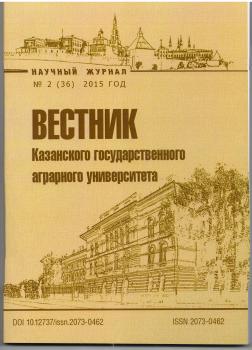The absence of early-maturing perennial grasses forces livestock producers to feed cattle 150-200 thousand hectares of winter rye on May 15-20, which could be saved for grain in case of widespread adoption of Galega, that is not inferior in terms of precocity. Most importantly, in market conditions it is necessary to cultivate long-used, self-renewing perennial agrocenoses in order to obtain products with a minimum prime cost. The study of the biological features of eastern goat's rue shows that it perfectly fits all of the above mentioned terms. Goat’s rue (Galega orientals) can become the leading fodder culture of Tatarstan for the following reasons: eastern goat’s rue, unlike all legumes of perennial grasses, has a unique ability of vegetative reproduction and the duration of its productive longevity increases to 12-15 years, so the costs of cultivation are reduced by 2-3 times, compared with the widely spread alfalfa seed; this culture is expedient for cultivation in remote shallow-contour fields, which significantly reduces the cost of annual distances of large-size combine harvesters and sowing complexes, the attention of large investors attracts its ability to grow early in the spring. For example, in our experiments it reached the slope ripeness on May 20-25 and outstripped alfalfa by sowing for precociousness for 15-20 days; the early ripeness of eastern goat’s rue makes it possible to preserve winter rye crops for grain traditionally used for green forage early in the spring; in contrast to alfalfa and clover meadow, in the preparation of hay and haylage, the leaves of the goat’s rue can not practically fall and feed corresponds to the highest class of nutrient content. The soil and climatic resources of the Republic of Tatarstan fully correspond to the conditions for the introduction of the eastern goat’s rue (Galega) into agricultural production on a large scale.
Eastern goat’s rue, raw material base, biological features, climatic resources, moisture availability, productivity and quality of feed.
Многовековая история человечества тесно связана с отбором и возделыванием в качестве продуктов питания разнообразных растений, включая виды хлебных злаков.
Для этих целей человек постепенно освоил технологию их возделывания, установил оптимальные сроки посева, норму высева, изобрел простейшие орудия труда. В итоге, мы достигли в области сельского хозяйства уникальных результатов, поскольку начали возделывать овощные и технические культуры. Таким образом, значительно улучшили рацион своего питания и обеспечили себя одеждой и другими товарами повседневного спроса.
Несмотря на это, проблема интродукции новых растений в сельскохозяйственное производство не только вечна, но и весьма актуальна, так как в последние 150-200 лет лишь единичные представители дикой флоры нашли свое место на наших полях [1, 2].
Условия, материалы и методы исследований. Теоретические основы интродукции козлятника восточного были разработаны на основе изучения научной литературы [1, 2, 3], опыта работы научно-исследовательских институтов, анализа почвенно-климатических условий нашего региона и учета биологических особенностей объекта исследований.
Результаты исследований и их обсуждение. Для освоения новой культуры, каким является козлятник восточный в нашей республике, он должен соответствовать следующим требованиям:
- биологическая особенность нового растения должно быть адоптирована к почвенно-климатическим условиям зоны его внедрения. Культура найдет свое место тогда, когда агроэкологические требования нового растения, и почвенно-климатические ресурсы совпадут по принципу полярного знака;
- должно присутствовать комплексное преимущество культуры, а не одиночные ее признаки;
- необходимо иметь сырьевую нишу, которую традиционно возделываемые культуры в силу своих биологических особенностей не могут ее заполонить.
Так, в Республике Татарстан до сих пор не решена проблема организации раннего звена травяного конвейера. Отсутствие раннеспелых многолетних трав вынуждает производителей животноводческой продукции 15-20 мая скармливать скоту 150-200 тыс. га озимой ржи, которую можно было бы сохранить на зерно в случае широкого внедрения в производство не уступающую по скороспелости культуру галега [4, 5, 6].
1. Safiollin F.N. Kozlyatnik vostochnyy. [Eastern goat’s rue]. / F.N. Safiollin. - Kazan, 2013. - P. 238.
2. Shaytanov O.L. Kozlyatnik vostochnyy v Tatarstane. [Eastern goat’s rue in Tatarstan]. / O.L. Shaitanov, Kh.Z. Karimov. - Kazan: TatNIISKh, - 2004. - P. 100.
3. Safiollin F.N. Ekologo-khozyaystvennaya otsenka poymennykh lugov. [Ecological and economic assessment of floodplain meadows]. - Kazan, 2012. - P. 326.
4. Minnullin G.S. Influence of mineral fertilizers on the quality of fodder of goat’s rue agrocenoses. [Vliyanie mineralnykh udobreniy na kachestvo korma kozlyatnikovykh agrotsenozov]. / G.S. Minnullin, L.T. Vafina, N.F. Vafin, M.M. Khismatullin // Vestnik Kazanskogo gosudarstvennogo agrarnogo universiteta. - The Herald of Kazan State Agrarian University, 2015, №4. - P. 81-83
5. Minnullin G.S. Macro- and microelement nutrition of oilseeds. [Makro- i mikroelementnoe pitanie maslichnykh kultur]. - Kazan: KSU Publishing, 2008. - P. 377.
6. Safiollin F.N. Perspektivnye napravleniya razvitiya kormoproizvodstva v Respublike Tatarstan. // Sb.nauchn. trudov. Penzenskoy s.-kh akademii. (Perspective directions of fodder production development in the Republic of Tatarstan. / F.N. Safiollin, G.S. Minnullin, R.K. Vafin // The collection of scientific works of Penza Academy of Social Sciences). - Penza: 2001. - P. 82-85.





